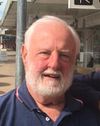Simple Wonders: Exhibition of the Paintings from the Collection of Andrew Johns Part Eleven: Colin Parker, Stuart McKenzie Cullen, Christine Graieg & Ric Elliot
And in my eyes there is nothing more enchanting than a country laneway lined with an old fence and flanked by tired country buildings "who" have served our rural communities well and are now resting while awaiting the artist's brush and palette to arrive.
Australian born Colin Parker (1941-) has captured in Sofala Lane this quintessential scene perfectly.
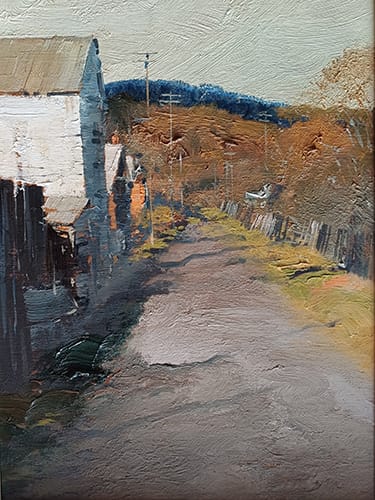
Colin Parker is best known for his paintings of the harsh isolation of the outback in bold and colourful lines. He has been an Artist in Residence at both Ayers Rock (sic) and Kakadu and is a respected Art Judge and four-time Wynne Prize winner. 1
Next we see a Street Scene by English born Ric Elliot (1933-1995) who became known for his traditional Australian scenes. He was a self-taught artist, and recorded many of the older areas of Sydney. He also painted series on such themes as Banjo Patterson and Australian bushrangers. He has held numerous one-man exhibitions and is represented in the national collection in Canberra. 2
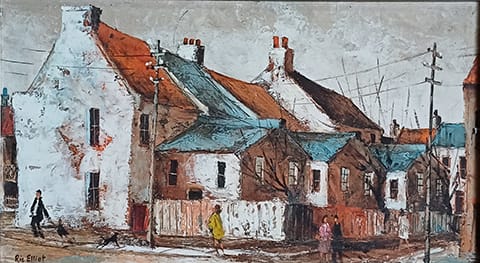
Silver City View by Christine Graieg (below) takes us north to see an architectural feature known as a Queenslander considered to be one of Australia's most iconic architectural styles.3
This one is on Christmas Island where Christine worked as a part time artist while teaching at the school which included children who arrived with their asylum seeking families- all by boat in extraordinarily difficult and dangerous circumstances. Andrew purchased this painting while also working on Christmas Island.
Silver City is a settlement within the village of Flying Fish Cove in Christmas Island, Australia. In the population there are Chinese, European, and a minority of Malays. The settlement was founded in the 1970s.3
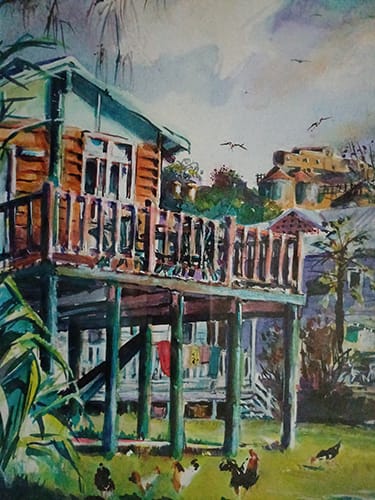
The quintessential Queenslander is a single detached house made of timber with a corrugated iron roof located on a separate block of land. They are all high-set, single-storey dwellings with a characteristic veranda that extends around the house to varying extents but never entirely surrounds it. In later years, many have been renovated to enclose part or all of these verandas to create extra bedrooms. The under-house area is often also enclosed to provide extra living area to these houses, which leads to the common misconception that an authentic Queenslander has two storeys.3
The raising of the main living spaces off the ground can be seen as both a stylistic and practical device.3 Take a moment to study Christian's painting and particularly the chooks enjoying their free range life which includes shelter from the burning sun under the Queenslander.
The vertical "stumps", initially of timber, allow the building to "float" above the terrain. Queenslanders all have this underfloor area that is used to cool the building through ventilation and also for protection of the main structure from termite and other pest attacks.3
Finally, Stuart McKenzie Cullen (see below) was born in Manchester, England in 1933, trained as a lithographic artist and designer and studied at the Manchester Royal College of Art. 4
He arrived in Australia in 1967 ... and is principally a landscape artist working in oils. His works depict scenes in Sydney and the New South wales countryside. 4
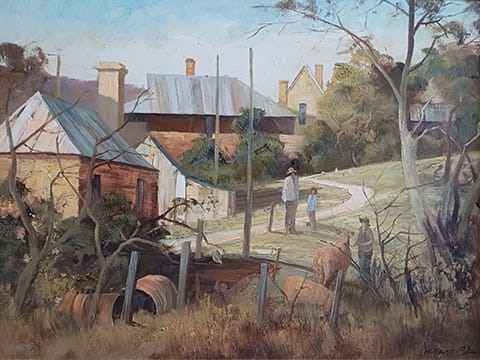
Tomorrow, Andrew and I are having the day off and then we will return with the last two posts showcasing the paintings from the Simple Wonders exhibition at the Singleton Arts and Cultural Centre from 23 August to 3 November 2024. Please use the search tool at the top of the post with the key words Simple Wonders to locate the previous posts.
‘All artwork images © the artists. All Simple Wonders exhibition images used with permission of Singleton Arts + Cultural Centre.’
Credits
1.charlestons.com.au/artist/colin-parker
2. kabgallery.com/artist/ric-elliot/bio
3. en.wikipedia.org
5. Australian and New Zealand Art Sales Digest, aasd.com.au

